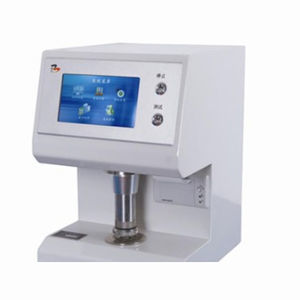
- Company
- Products
- Catalogs
- News & Trends
- Exhibitions
Temperature testing system LTKBXS-01performancemoisturepaper and cardboard

Add to favorites
Compare this product
Characteristics
- Test type
- temperature, performance, moisture
- Tested product
- paper and cardboard
- Applications
- industrial, laboratory
- Configuration
- benchtop
Description
It is suitable for measuring the water absorption of various paper or cardboard surfaces. But it is not suitable for accurately evaluating the absorption performance of paper or cardboard.
Test principle Water absorption (Cobb) value on the surface of paper and cardboard: paper and cardboard per unit area under certain pressure and temperature.
Principle:
The amount of water absorbed by the surface within the specified time, in g/㎡. The specific formula is as follows: C=(G2-G1)×100.
In the formula: C-water absorption value; G2-the mass of the sample weighed out after water absorption; G1-the mass of the sample weighed out before water absorption the amount.
Paper and cardboard absorbency tester is a conventional instrument for water absorption test on paper and cardboard surface, also known as paper surface
Absorption weight tester. This instrument uses the Cobb test method among the various methods of absorption test, so it is also
It is called the cobb absorbability tester.
• Test area : 100±0.2cm²
• Corresponding internal meridian : 112.8±0.2mm
• Metal cylinder height : 50mm
• Roll width : 200±0.5mm
• Roller mass : 10±0.5kg
• Dimensions : 480×400×420 (mm)
• Weight : 28kg
• Ambient temperature : 15℃-35℃
Reference standard
GB/T1540-2002 Test Method for Water Absorption of Paper and Paperboard (Keber Method)
Instrument configuration
Main machine, standard pressure roller, one measuring cylinder 100ML, one pack of qualitative filter paper
Catalogs
No catalogs are available for this product.
See all of linktesting‘s catalogsRelated Searches
- Test machine
- Material testing machine
- Automatic test machine
- PC-controllable testing machine
- Vertical test machine
- Industrial test machine
- Digital tester
- Laboratory test machine
- Industrial testing system
- Precision test machine
- Automatic testing system
- Plastic test machine
- Resistance test machine
- Digital test machine
- Packaging test machine
- Tester with LCD screen
- USB tester
- Resistance testing system
- Benchtop testing system
- Tensile strength test machine
*Prices are pre-tax. They exclude delivery charges and customs duties and do not include additional charges for installation or activation options. Prices are indicative only and may vary by country, with changes to the cost of raw materials and exchange rates.






